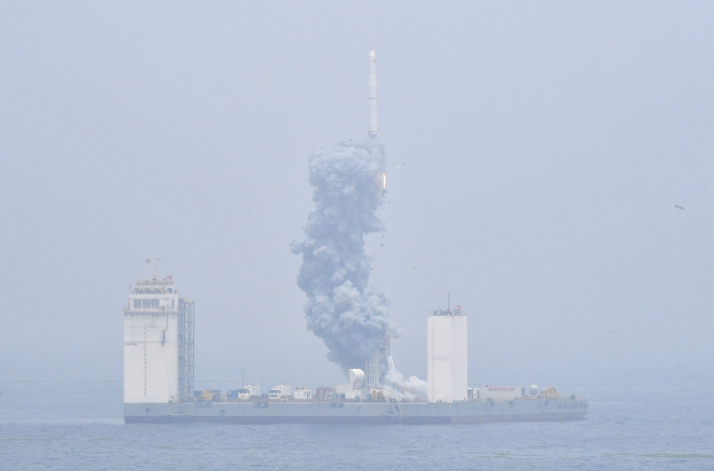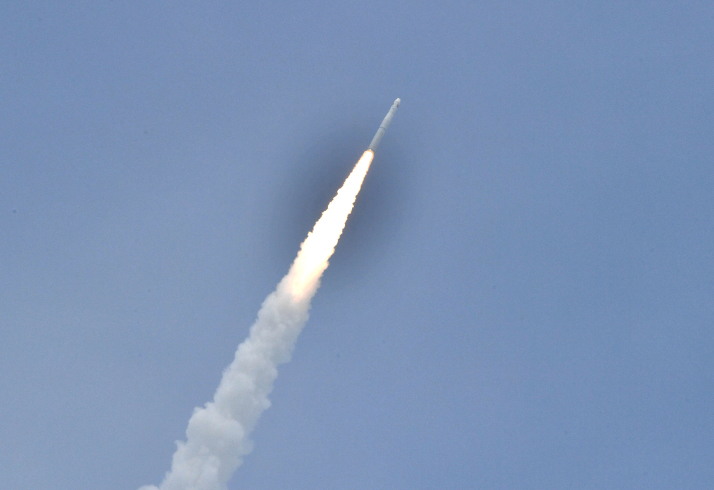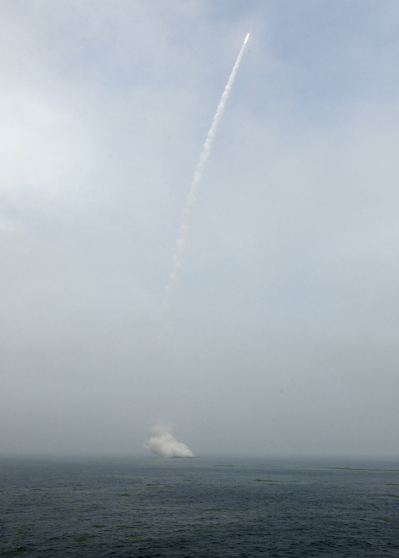|
||||||
|
||||||
| Home Nation World Business Opinion Lifestyle China Focus ChinAfrica Video Multimedia Columnists Documents Special Reports |
|
||||||
|
||||||
| Home Nation World Business Opinion Lifestyle China Focus ChinAfrica Video Multimedia Columnists Documents Special Reports |
| Nation |
| From the Sea |
| China's first seaborne satellite launch is a full success |
| By Yuan Yuan · 2019-06-17 · Source: NO.25 JUNE 20, 2019 |
 A Long March-11 solid propellant carrier rocket is launched from a mobile launch platform in the Yellow Sea off the coast of east China's Shandong Province on June 5 (XINHUA)
With a blast coming out of the Yellow Sea on June 5, China successfully launched a rocket from a sea-based platform for the first time, making it the third country after the United States and Russia to master sea launch technology. The Long March 11 solid propellant carrier rocket is the 306th mission of the Long March carrier rocket series. Two technology experiment satellites and five commercial satellites were sent into space in the latest mission.  A Long March-11 solid propellant carrier rocket is launched from a mobile launch platform in the Yellow Sea off the coast of east China's Shandong Province on June 5 (XINHUA)
New launch Gao Lei, Administrative Commander of the control system of the Long March 11 carrier rocket, explained on China Central Television (CCTV) that there were quite a few advantages of launching it from the sea. It can bring down launch costs since it can get closer to the equator, where Earth's spin naturally provides a speed boost and decreases the amount of fuel needed for the rocket to reach orbit, Gao said. It also reduces the possibility of damage on the ground from falling rocket debris. Before this launch, all the space launch centers in China were based on land. Wenchang Satellite Launch Center, in south China's Hainan Province, is the southernmost center and the only one near the sea. But it is also located at 19 degrees north latitude and can't launch missions with an inclination between 0 and 19 degrees. Sea launches can fill this gap. Jin Xin, Deputy Project Manager of the Long March 11 rocket, told China Youth Daily that the sea launch will meet the growing need for launching near-equatorial and low-inclination satellites, and improving rockets' adaptability. He added that the construction of land launch centers is costly with many factors to consider. "It has to be far from residential areas to reduce the possibility of injury from the tremendous noise and falling debris," Jin said. "In sparsely populated areas, residents have to be relocated before launches to avoid possible damages." In the following 10 years, about 1,700 small commercial satellites in China need to be sent into space, such a situation will increase the inconvenience for more frequent space launches, according to Jin. "In previous launches, the safety of the launched rockets was monitored by staff on the ground, but this time it was the rocket itself that automatically monitored and controlled its situation," said Guan Hongren, Deputy Chief Designer of the Long March 11 rocket. Although seaborne launches can perfectly solve some issues, they have their own set of problems. Compared to land launch platforms, the seaborne platform has to deal with the challenges of ocean waves, which greatly affect the aiming accuracy. "We have adopted a special aiming technology and launching technology under dynamic conditions to deal with this," Guan said. In addition, in land-based launches, rocket control and monitoring signals can be transmitted through wired communication systems, while in sea-based launches they can only be achieved through wireless transmission. Thus, this was also the first time that wireless transmission was adopted in monitoring, launching and controlling a launched rocket in China, Guan noted. "The marine environment is different from land. The rocket must adapt to high humidity, salty fog and complicated electromagnetic conditions," Li Tongyu, Commander in Chief of the Long March 11 rocket project. "The Long March 11 carrier rocket, nearly 21 meters long and weighing 58 tons, can send 500 kg of payload into 500 km of Sun-synchronous orbit."  Images of the Long March 11 solid propellant carrier rocket as it is launched from a sea-based launch platform in the Yellow Sea off the coast of east China's Shandong Province on June 5 (XINHUA)
Expanding services China started developing modern carrier rockets in 1956, and the Long March rockets have become the main carriers for its satellite launches. The Long March 11, developed by the China Academy of Launch Vehicle Technology, is the only rocket using solid propellants among China's new generation of carrier rockets. It is mainly used to carry small satellites and can take multiple satellites into orbit at the same time. Before this mission, the rocket had completed six launches, placing 25 satellites into space. "The solid-propellant Long March 11 rockets have strong quick-response ability at low prices, which provide better, competitive services in space business," Li said. Among the seven satellites launched with the rocket, two experimental ones, Bufeng-1A and Bufeng-1B developed by the China Academy of Space Technology, are expected to monitor ocean wind fields and improve typhoon monitoring and the accuracy of weather forecasting in China. The launch is China's 10th so far this year, with a planned total of 30 by the end of the year. It also taps into the commercial potential of space launches. In the future, the Long March 11 rocket team will carry out more seaborne launch tests to monitor the rockets' adaptability in various orbits and further optimize the launching process and capability. Li said the China Academy of Launch Vehicle Technology plans to develop and construct a coastal port to support seaborne launch missions. "Many countries participating in the Belt and Road Initiative are located near the equator," Li said. "Seaborne launch technology will meet the growing launch demand of low inclination satellites and help China provide launch services for these countries." Copyedited by Rebeca Toledo Comments to yuanyuan@bjreview.com |
About Us | Contact Us | Advertise with Us | Subscribe
|
||
| Copyright Beijing Review All rights reserved 京ICP备08005356号 京公网安备110102005860号 |